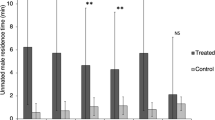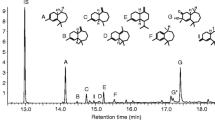Abstract
Male and female Spathius agrili Yang were tested for attraction to the synthetic male pheromone. Lures consisting of a 3-component pheromone blend were placed in the center of a white filter paper target used to activate upwind flight in the wind tunnel. When virgin males and females were tested for attraction, both sexes were attracted to the lure prior to mating. However, only males were attracted to the pheromone lures after mating. In another experiment, of females that flew to the lure as virgins, half were subsequently mated and the other half were not, and mated females were no longer attracted. Then both mated and virgin females were provided with host material (emerald ash borer larvae in sticks of ash) to determine if oviposition affected attraction. They were supplied with fresh hosts ad libidum and subsequently tested for attraction for 55 days, and results showed that oviposition did not affect attraction to the pheromone. The key factor in attraction to the pheromone was mating. Because this pheromone is released by one sex and is attractive to both sexes for the purpose of mating, it qualifies as an “aggregation-sex pheromone”.
Similar content being viewed by others
References
Ayasse M, Paxton RJ, Tengö J (2001) Mating behavior and chemical communication in the order hymenoptera. Annu Rev Entomol 46:31–78
Bauer LS, Liu H, Miller D, Gould J (2008) Developing a classical biological control program for Agrilus planipennis (Coleoptera: Buprestidae), an invasive ash pest in North America. News Mich Entomol Soc 53:38–39
Bauer L, Gould J, Duan J, Hansen J, Cossé A, Miller D, Abell K, Van Driesche R, Lelito J, Poland T (2011) Sampling methods for recovery of exotic emerald ash borer parasitoids after environmental release. In: Proceedings of the 22nd USDA Interagency Research Forum on Invasive Species, pp. 2–4
Bergström G, Wassgren A-B, Adnerbrant O, Fägerhag J, Edlund H, Hedenström E, Högberg H-E, Geri C, Auger MA, Varama M et al (1995) Sex pheromone of the pine sawfly Diprion pini (Hymenoptera: Diprionidae): chemical identification, synthesis and biological activity. Experientia 51:370–380
Butenandt A, Beckmann R, Stamm D, Hecker E (1959) Über den sexual-lockstoff des seidenspinners Bombyx mori. Z Naturforsch 14b:283
Cardé RT (2014) Defining attraction and aggregation pheromones: teleological versus functional perspectives. J Chem Ecol 40:519–520
Consoli FL, Williams HJ, Vinson SB, Matthews RW, Cooperband MF (2002) trans-Bergamotenes - male pheromone of the ectoparasitoid Melittobia digitata. J Chem Ecol 28:1675–1689
Cooperband MF, Böröczky K, Hartness A, Jones TH, Zylstra KE, Tumlinson JH, Mastro VC (2012) Male-produced pheromone in the European woodwasp, Sirex noctilio (Hymenoptera: Siricidae). J Chem Ecol 38:52–62
Cooperband MF, Hartness A, Lelito JP, Cossé AA (2013) Landing surface color preferences of Spathius agrili (Hymenoptera: Braconidae), a parasitoid of emerald ash borer, Agrilus planipennis (Coleoptera: Buprestidae). J Insect Behav 26:721–729
Cossé AA, Bartelt RJ, Weaver DK, Zilkowski BW (2002) Pheromone components of the wheat stem sawfly: identification, electrophysiology, and field bioassay. J Chem Ecol 28:407–423
Cossé AA, Petroski RJ, Zilkowski BW, Vermillion K, Lelito JP, Cooperband MF, Gould JR (2012) Male-produced pheromone of Spathius agrili, a parasitoid introduced for the biological control of the invasive emerald ash borer, Agrilus planipennis. J Chem Ecol 38:389–399
Duan JJ, Oppel CB, Ulyshen MD, Bauer LS, Lelito J (2011) Biology and life history of Tetrastichus planipennisi (Hymenoptera: Eulophidae), a larval endoparasitoid of the emerald ash borer (Coleoptera: Buprestidae). Fla Entomol 94:933–940
El-Sayed AM, Gödde J, Arn H (1999) Sprayer for quantitative application of odor stimuli. Environ Entomol 28:947–953
Gonzalez JM, Matthews RW, Matthews JR (1985) A sex pheromone in males of Melittobia australica and M. femorata (Hymenoptera: Eulophidae). Fla Entomol 68:279–286
Gould J, Bauer L, Duan J, Fraser I, Hansen J, Ulyshen M, Lelito J (2011) Release and recovery of parasitoids of the emerald ash borer (EAB), Agrilus planipennis in MI, OH, and MD. In: Proceedings of the 22nd USDA Interagency Research Forum on Invasive Species, pp. 24–25
Haack RA, Jendeck E, Liu H, Marchant KR, Petrice TR, Poland TM, Ye H (2002) The emerald ash borer: a new exotic pest in North America. News Mich Entomol Soc 47:1–5
Hooie NA, Wiggins GJ, Lambdin PL, Grant JF, Powell SD, Lelito JP (2015) Native parasitoids and recovery of Spathius agrili from areas of release against emerald ash borer in eastern Tennessee, USA. Biocontrol Sci Tech 25:345–351
Jewett D, Matsumura F, Coppel HC (1976) Sex pheromone specificity in the pine sawflies: interchange of acid moieties in an ester. Science 192:51–53
Kovacs KF, Haight RG, McCullough DG, Mercader RJ, Siegert NW, Liebhold AM (2010) Cost of potential emerald ash borer damage in U.S. communities, 2009–2019. Ecol Econ 69:569–578
Liu H, Bauer LS, Miller DL, Zhao T, Gao R, Song L, Luan Q, Jin R, Gao C (2007) Seasonal abundance of Agrilus planipennis (Coleoptera: Buprestidae) and its natural enemies Oobius agrili (Hymenoptera: Encyrtidae) and Tetrastichus planipennisi (Hymenoptera: Eulophidae) in China. Biol Control 42:61–71
Onagbola EO, Fadamiro H (2011) Response of pteromalus cerealellae to conspecific odor: evidence for female- and male-produced pheromones? J Stored Prod Res 47:393–398
Poland TM, McCullough DG (2006) Emerald ash borer: invastion of the urban forest and the threat to North America’s ash resource. J For 104:118–124
Quicke DLJ (1997) Parasitic wasps. Chapman & Hall, London, UK
Ruther J, Stahl LM, Steiner S, Garbe LA, Tolasch T (2007) A male sex pheromone in a parasitic wasp and control of the behavioral response by the female’s mating status. J Exp Biol 210:2163–2169
Sullivan B (2002) Evidence for a sex pheromone in bark beetle parasitoid Roptrocerus xylophagorum. J Chem Ecol 28:1045–1063
Swedenborg PD, Jones RL (1992) Multicomponent sex pheromone in Macrocentrus grandii Goidanich (Hymenoptera: Braconidae). J Chem Ecol 18:1901–1912
Ulyshen MD, Duan JJ, Bauer LS (2010) Interactions between Spathius agrili (Hymenoptera: Braconidae) and Tetrastichus planipennisi (Hymenoptera: Eulophidae), larval parasitoids of Agrilus planipennis (Coleoptera: Buprestidae). Biol Control 52:188–193
van Beek TA, Silva IMMS, Posthumus MA, Melo R (2005) Partial elucidation of Trichogramma putative sex pheromone at trace levels by solid-phase microextraction and gas chromatography–mass spectrometry studies. J Chromatogr A 1067:311–321
Vinson SB (1972) Courtship behavior and evidence for a sex pheromone in the parasitoid Campoletis sonorensis (Hymenoptera: Ichneumonidae). Environ Entomol 1:409–414
Wang X-Y, Yang Z-Q, Gould JR, Wu H, Ma J-H (2010) Host-seeking behavior and parasitism by Spathius agrili Yang (Hymenoptera: Braconidae), a parasitoid of the emerald ash borer. Biol Control 52:24–29
Weseloh RM (1976) Dufour’s gland: source of sex pheromone in a hymenopterous parasitoid. Science 20:695–697
Yang Z-Q, Strazanac JS, Marsh PM, Van Achterberg C, Choi W-Y (2005) First recorded parasitoid from China of Agrilus planipennis: a new species of Spathius (Hymenoptera: Braconidae: Doryctinae). Ann Entomol Soc Am 98:636–642
Yang Z-Q, Wang X-Y, Gould JR, Reardon RC, Zhang Y-N, Liu G-J, Liu E-S (2010) Biology and behavior of Spathius agrili, a parasitoid of the emerald ash borer, Agrilus planipennis, in China. J Insect Sci 10:1–13
Acknowledgments
We thank Juli Gould and Tracy Ayer for their assistance and with S. agrili. We also extend thanks to David Lance and Russ Bullock for their comments on the manuscript. The parasitoids were produced and supplied from the United States Department of Agriculture’s Animal and Plant Health Inspection Service (APHIS), Plant Protection and Quarantine (PPQ) EAB parasitoid rearing facility in Brighton, MI. Mention of a commercial product does not constitute an endorsement or recommendation for its use by USDA.
Author information
Authors and Affiliations
Corresponding author
Rights and permissions
About this article
Cite this article
Cooperband, M.F., Hartness, A., Zilkowski, B. et al. Attraction of Spathius Agrili Yang (Hymenoptera: Eulophidae) to Male-Produced “Aggregation-sex Pheromone”: Differences Between the Sexes and Mating Status. J Insect Behav 28, 167–174 (2015). https://doi.org/10.1007/s10905-015-9492-6
Revised:
Accepted:
Published:
Issue Date:
DOI: https://doi.org/10.1007/s10905-015-9492-6




